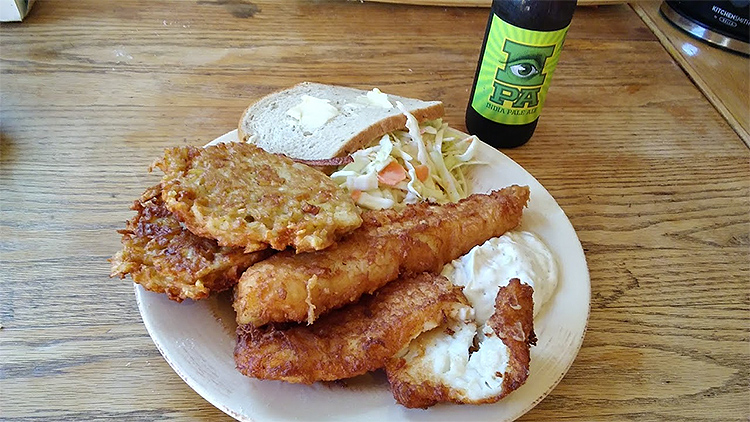Caleb Westphal hasn’t missed a Friday fish fry since 2013. Follow along with his never-ending adventures here.
When things started getting dicey back in March, I stocked my freezer up with fish. Like many others at the time, I was attempting to prepare for the unknown. Beyond the unknown of how bad the virus would get in our state and city—which there still is no answer to—there was the unknown of how many people would be out of work, the unknown of how hard it would get to procure basic supplies like soap and toilet paper, and in my mind, the unknown of how hard it would get to find a Friday night fish fry. It seemed likely that if restaurants had to close for dine-in they would still offer pickup, and this is what ended up being the case. But what if that hadn’t ended up happening? What if fish ended up only being found in stores? And what if things had gotten bad enough and the stores had to close, and an apocalyptic nightmare ensued where people had to fend for themselves and hunt, gather, scavenge, and fish for food?
Luckily, that didn’t end up happening. (Things aren’t going to get worse from here on out, right?) But a question has been in my mind for months: If there was no place to buy either a fish fry or fish to fry, could I catch some fish at the closest body of water to my house and use them to make my own fish fry? This past Friday I grabbed my fishing poles and walked to the pond in Humboldt Park in order to answer my question. I’d fished there once four years ago and caught a sunfish. I’ve also seen people pull in perch and crappie, and someone once told me they caught trout there as well. It seemed like there was a real chance I would be able to catch some fish and make my own meal.
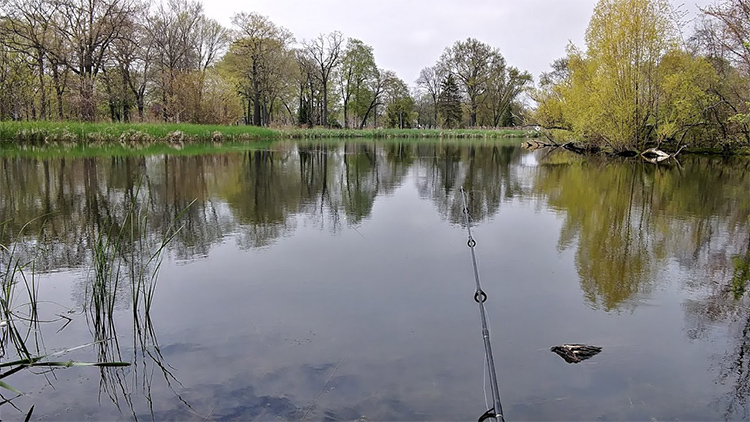
I started fishing at approximately 11 a.m. and didn’t stop for three and a half hours. For bait, I mainly used worms that I had dug up while hand tilling my garden the day before, but I also periodically used a small spinner that I had on a second pole. (I only once got it stuck in a tree and almost took out my eye.) I fished from every spot around the perimeter of the pond where there was access to the water, except the wooden dock on the pond’s west side, which was occupied when I was making my way around the pond clockwise. When I was at the opening before it, a guy yelled to me from it, asking me if I was going to keep what I caught. Maybe he was picturing himself in the middle of the apocalypse just like I was. No way, dude! It’s every human for themselves now! (I didn’t actually shout that back.) I ended up catching 14 fish: two bullheads, seven chubs, two carp, one goldfish, and two sunfish. None were longer than about six inches in length. Hey, it doesn’t always matter what you catch, as long as you catch something!
My question could have been answered in the affirmative. I caught 14 fish and could have taken them home and made a fish fry. But being that they were so small and were mainly rough fish, I decided against it and let them all go. I could have set out for a better fishing spot and still possibly caught dinner, but I felt I had answered the question that I had set out to answer, and that I should leave another fishing hole for another day. But after all the effort I had already put in, heading somewhere for a carryout fish fry felt like it would be a cop-out. And I did, after all, still have all that fish in my freezer.
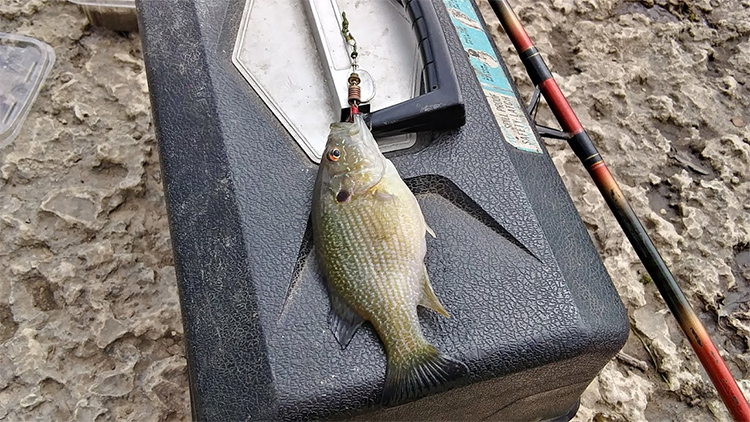
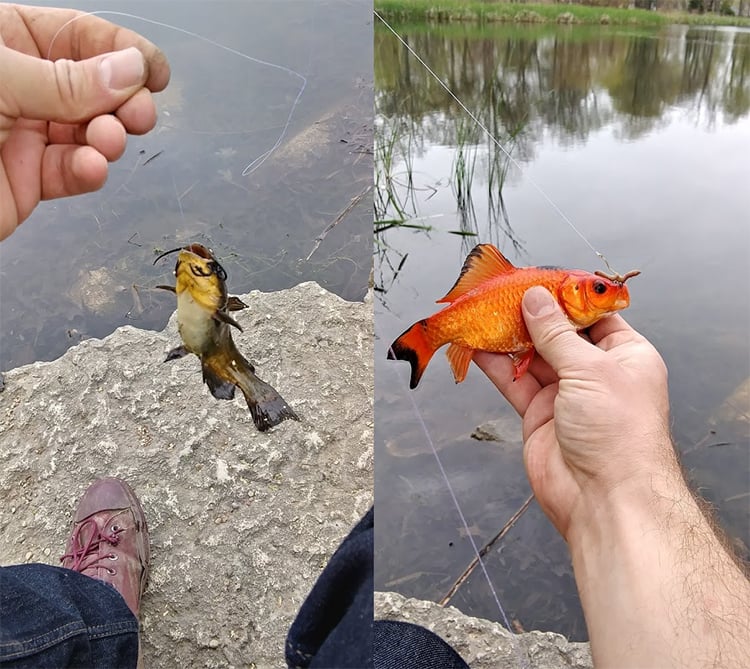
So I went home and made my own fish fry. I figured this would be the moment that I would be exposed as a fraud, as I really had no idea what I was doing. It would be the moment that would show I have no business telling anyone else about how to make fish, as I couldn’t even make my own. Sure, I’ve filleted fish before and I’ve pan fried them in flour. But I don’t think I’ve ever made beer batter, and I know I’ve never made homemade potato pancakes. This was to be a moment of truth.
I started out by making the coleslaw, which was based off of a recipe that my mom remembered making at the Kentucky Fried Chicken she worked at somewhere outside of Madison in 1982. I cut a head of cabbage in half and used one of the halves, slicing it thin and tossing it in a large Pyrex bowl. I was going to grate three carrots to add to the mix, but I realized I didn’t have a grater, so I used a metal slicer instead. I whisked mayonnaise, sugar, red wine vinegar, and olive oil in a bowl and poured it over the vegetables, and I topped it with a small dash of pepper before I mixed it together. The only difference between my recipe and the original was I used red wine vinegar instead of white vinegar and I added pepper. So, this wasn’t slaw for Kentucky Fried Chicken—this was for Wisconsin Fried Fish.
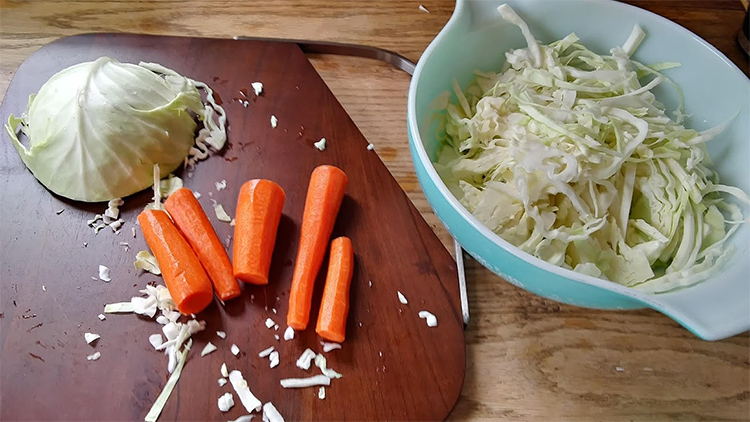
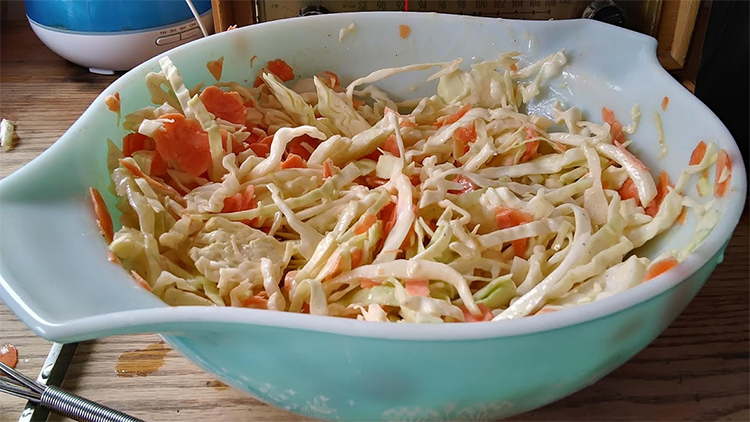
Next, I mixed up some tartar. My memories of making tartar as a kid consist of simply mixing mayonnaise with pickle relish. This time around I mixed Miracle Whip with relish from the half jar that Tyler Maas gave me back in March. I augmented it with some lemon juice, pepper, and dill. There wasn’t a recipe I based it on—I just went for it.
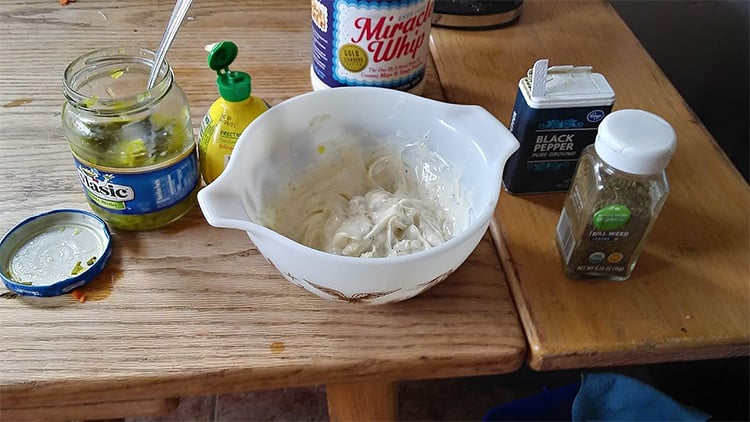
Then I went for the potato pancakes. I have a friend who is a chef who lives in New York City. As her city became the epicenter of the pandemic, she sheltered inside her small apartment. But that didn’t stop her from cooking. One day she posted a photo of some potato pancakes she made. After I asked about the recipe, she sent me a copy. It was from the Malone Area Heritage Museum, a place where her mom and step dad volunteer. After the museum’s “Old Fashion Country Breakfast” was canceled due to the coronavirus, the museum printed their potato pancake recipe in one of their newsletters. My friend’s mom sent her the recipe. While the virus raged outside her doors, this Wisconsin native fried up and gained strength from a Wisconsin fish fry staple. This past Friday, I brought the recipe back to its home state.
I felt like I was off to an inauspicious start when I couldn’t grate the potatoes like the first step in the recipe told me to do, since I didn’t have a grater. Instead, I used a chef’s knife to cut three peeled russet potatoes into strips similar to those that would be used to make hash browns. I cut some onion in a similar fashion and threw both into a food processor and gave it a few taps, just to gently cut them up a bit more. Next, I whisked together two eggs, flour, salt, pepper, baking powder, and dill—the one ingredient that wasn’t on the original recipe. I mixed this with the potatoes and onions. I heated some canola oil in a pan on the stove, plopped three balls of the mixture down and flattened them like a pancake—albeit a thick one—and flipped them once, cooking them about five minutes on each side.
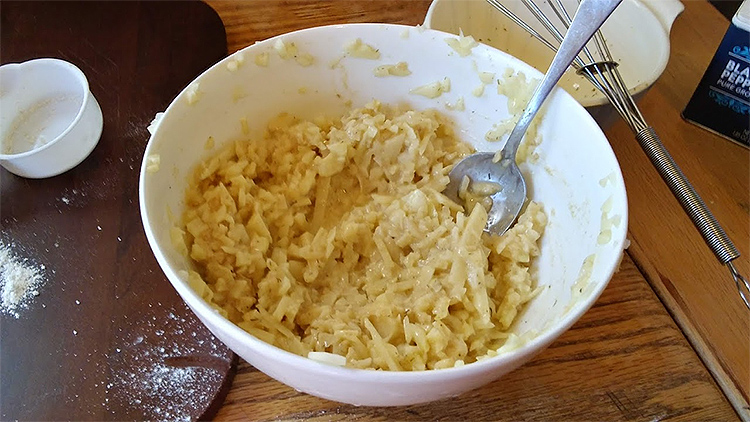
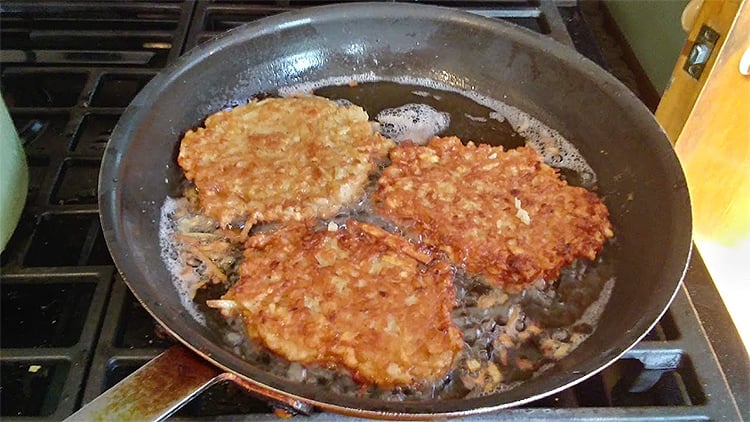
Being that I had been confident I was going to have fresh fish to fry, I hadn’t taken the frozen fish out of the freezer until I came home empty handed. It wasn’t thawed by the time I needed it to be, so I gently defrosted it in the microwave, being careful not to compromise its quality. The first package I used had two fillets of “wild caught cod.” I had purchased it at Pick ‘n Save on March 12, right about the time when everyone started buying a lot of toilet paper. It had been on sale for $5.99 per pound and it weighed 1.16 pounds. The second package of fish I used had one fillet of “Wild caught Alaskan cod.” I had purchased it at Outpost Natural Foods on March 18, the most recent day I have been inside a grocery store. It cost $9.99 per pound and it weighed 0.5 pounds.
The recipe for the beer batter that I used was one my mom had given me, which was what she had recalled a neighbor who lived near us when I was growing up had once given her. No specifics of how much of each ingredient were included. It said to separate an egg and then beat the yolk before adding it to a can of beer (I used Pabst Blue Ribbon), flour, and salt. The egg whites were to be beaten separately until peaks formed, and were then to be folded into the rest of the mix. After doing all this and dunking in a piece of fish, the beer batter appeared a bit too runny. I mixed in some more flour until it thickened a bit.
On the stove I had a large pot with canola oil in it that I was heating up. A thermometer was attached to it going down into the oil, and once it hit 365 degrees I slowly lowered in a piece of fish. Initially the temperature gauge shot way up. At first I was going to shift the pot away from the flame, but realized that if I knocked the pot off the stove it probably would end my fish fry streak right there, so instead I just turned the heat down a bit. Then I added the second piece. This time the temperature went way down. I turned the stove up to try to stabilize it. I took the first piece out and put the third one in. It took the longest to cook and turn golden brown.
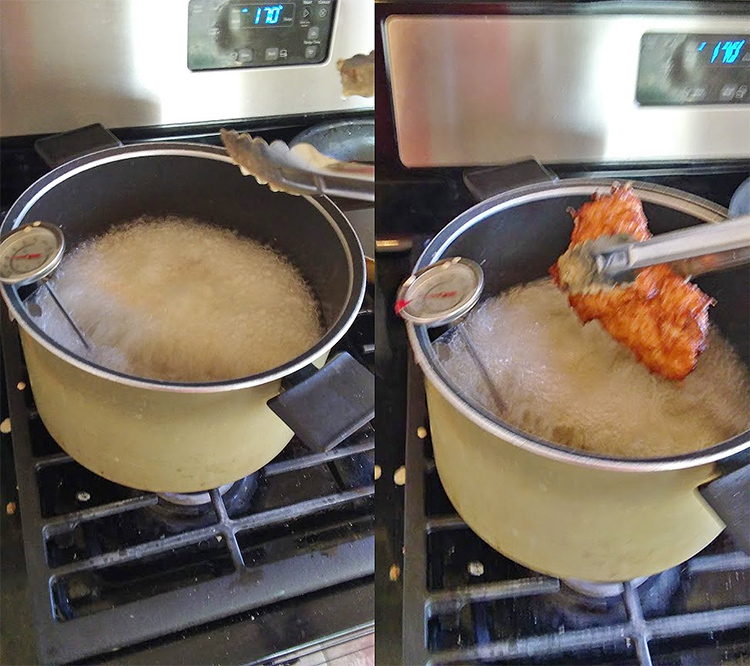
About eight hours after I had initially started trying to catch fish, it was time to eat. My overall takeaway of the meal was of surprise—I was surprised by how well it turned out. I had gone in thinking that I would possibly make a fool of myself, but what came out was a fish fry that I would have recommended everyone to try if it was at a restaurant. Even though I had failed in catching my own fish, even though the fish I did make had been sitting in my freezer for months, even though I had no grater, or hadn’t known how much of each of the ingredients to mix together for the beer batter, everything somehow turned out better than expected. At least this meant I could continue to go on writing about whether other people’s fish frys were any good or not.
This also showed me that making a fish fry from scratch is a lot of work. I can’t imagine sitting in a kitchen making fish frys all night, let alone standing over a hot deep fryer for a shift. Sure, things may go smoother if many meals are being made and the process becomes streamlined, but each step would still take a fair amount of time and effort. (Well, maybe except for buttering the rye bread—which was Beefsteak brand Seeded Hearty Rye, by the way.) Would I spend the time making a fish fry like this for myself every week? Well, if it was the only way to get a fish fry, I’d do it. But I think I’ll stick with carryout from restaurants for a while again. They need our support now more than ever.
Takeaways: I caught a goldfish and 13 other fish; it may be possible to fry your own fish from Humboldt Park, but I wouldn’t recommend it (although maybe you’d end up catching perch and crappies if you went fishing there); Kentucky Fried Chicken, psssh, more like Wisconsin Fried Fish—who is gonna start a restaurant chain with this name?; I had coleslaw with the next three non-breakfast meals that followed this meal; who needs to buy a deep fryer when you have an old pot; amazing potato pancakes; you don’t really need a potato grater to make potato pancakes, but it probably comes in handy; I earned my fish fry fryer badge.
